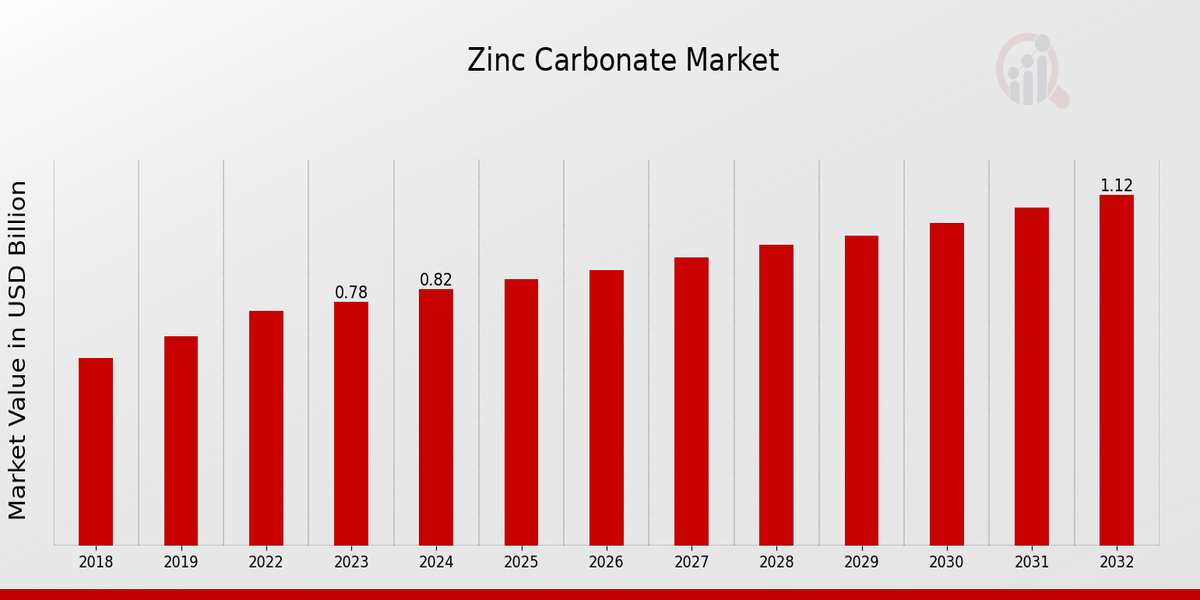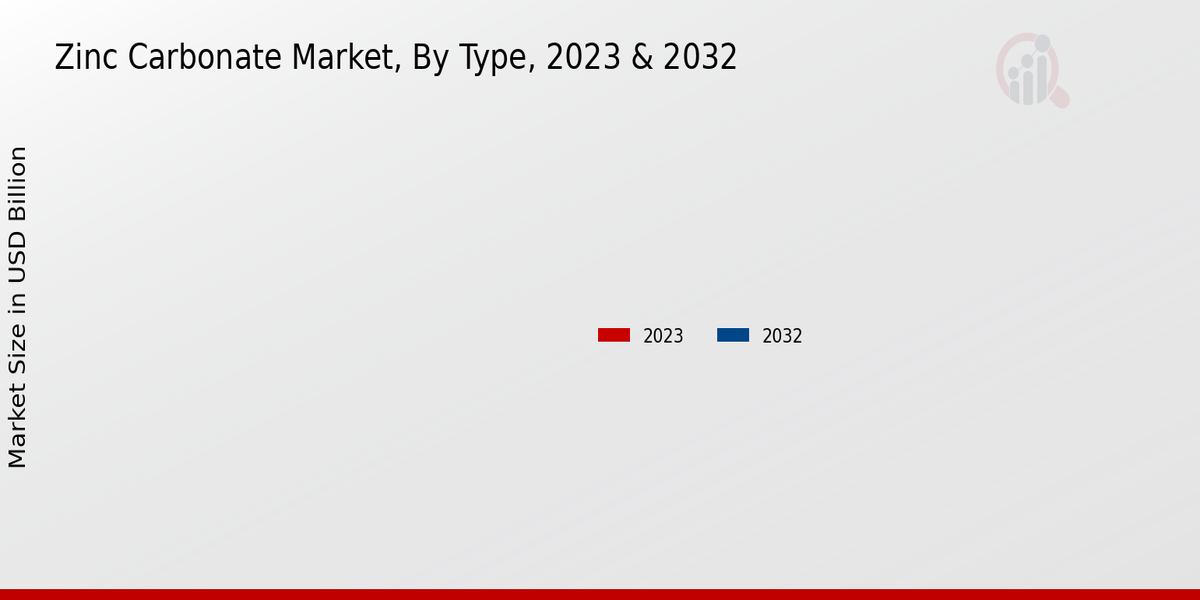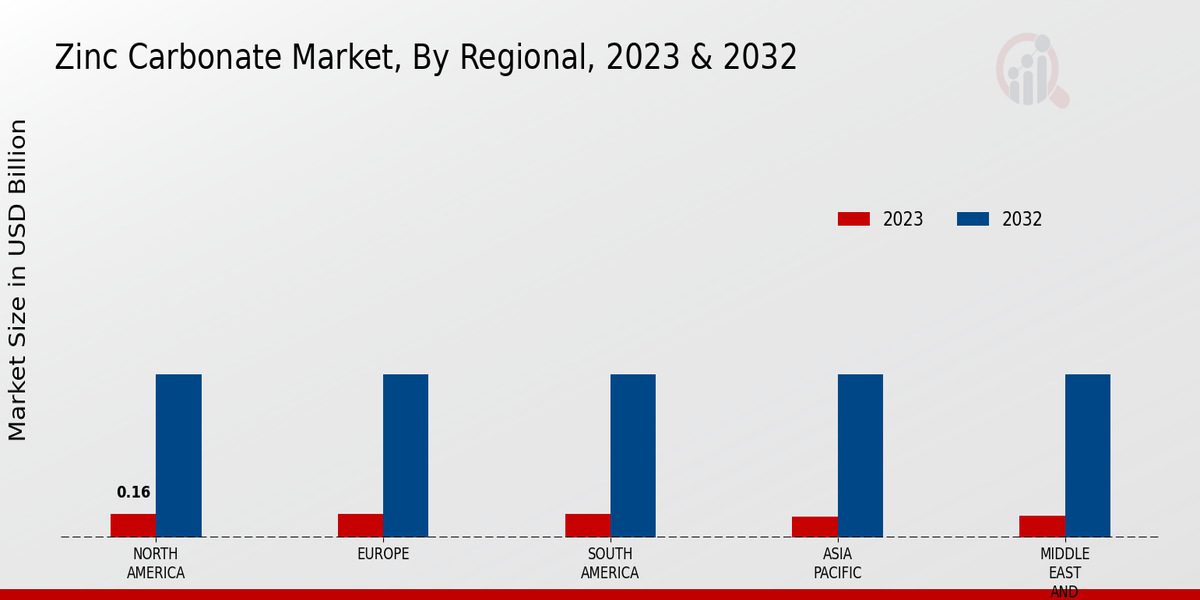Global Zinc Carbonate Market Overview
The Zinc Carbonate Market Size was estimated at 0.84 (USD Billion) in 2024. The Zinc Carbonate Industry is expected to grow from 0.88 (USD Billion) in 2025 to 1.25 (USD Billion) by 2034. The Zinc Carbonate Market CAGR (growth rate) is expected to be around 4.03% during the forecast period (2025 - 2034).
Key Zinc Carbonate Market Trends Highlighted
Key market drivers for zinc carbonate include its increasing use in the production of pharmaceuticals, particularly antacids and anti-diarrheal medications. The growing demand for zinc carbonate in personal care products, such as cosmetics and skincare, is also driving market growth. Moreover, the expanding automotive industry is driving demand for zinc carbonate as a corrosion inhibitor.Exploration opportunities in the Zinc Carbonate Market lie in the development of new applications in the construction industry, particularly in the production of fire retardant materials and concrete additives. Furthermore, the increasing use of zinc carbonate as a zinc supplement in food and beverage products presents growth opportunities.Recent trends in the zinc carbonate market include the shift towards sustainable and environmentally friendly production processes to reduce environmental impact. The rising popularity of natural and organic products is also driving demand for zinc carbonate derived from natural sources. Additionally, the growing awareness of the health benefits of zinc is contributing to the market's growth as zinc carbonate is a rich source of zinc, an essential nutrient for human health.

Source: Primary Research, Secondary Research, MRFR Database and Analyst Review
Zinc Carbonate Market Drivers
- Increasing Demand from the Construction Industry
Zinc carbonate is used in the construction industry as a chemical additive in cement, concrete and other building materials. Firstly, since the construction industry is experiencing a moderate rise due to a growing need to build new homes and commercial centers, the demand for zinc carbonate will likely increase. Secondly, the boost in urbanization and modernization in developing countries with a focus on the growth of the population will trigger a broader need for constructing new buildings and erecting an extensive range of other types of infrastructure.Finally, the increasing concern with environmental protection and social responsibility among the target audience will add to the use of eco-friendly materials. Zinc carbonate, in turn, is considered a rather safe additive.
Growing Applications in the Chemical Industry
Zinc carbonate has various applications in the chemical industry. Among the most notable ones is the production of different zinc compounds, such as zinc oxide and zinc sulfate. The aforementioned compound has diverse applications as a chemical agent, specifically to provide color, opacity, and hiding. Zinc oxide is utilized in the production of paints, ceramics, and rubber goods, which results in a high demand for the given chemical compound.Zinc sulfate, in turn, is used in fertilizers, animal feed, and electroplating. It can be suggested that the elevated demand for the given zinc compounds drives the rapid growth of the zinc carbonate market. In addition, it is applied as a catalyst in multiple chemical reactions and as a pigment in the production of paints and coatings.
Expanding Pharmaceutical and Cosmetic Applications
The medicinal and cosmetic attributes of zinc carbonate have attracted much attention from the pharmaceutical and cosmetic industries. The zinc carbonate in the pharmaceutical industry is used as an active compound in over-the-counter medications. It is also used as an ingredient in some dietary supplements as it is used in cases of zinc deficiency. In the cosmetics industry, zinc carbonate is used as an antiperspirant and as a deodorant. In addition, the compound is used to neutralize body odors.The demand for personal care products and increased skin-related ailments is also expected to spur the market.
Zinc Carbonate Market Segment Insights:
Zinc Carbonate Market Type Insights
At the current moment, the Zinc Carbonate Market is divided by Type into Activated Zinc Carbonate, Dense Zinc Carbonate, and Micro-and Nano-size Zinc Carbonate. The market size for Activated Zinc Carbonate was USD 0.36 billion in 2023, and it is expected to increase by 4.3% every year, leading to a revenue of $0.52 billion in 2032. The given type of zinc carbonate is typically utilized in the production of zinc oxide. This element is demanded in a wide range of industries, including, for instance, rubber, ceramics, and drug manufacturing.The appeal for zinc oxide is expected to grow, too, positively affecting the demand for activated zinc carbonate. In relation to Dense Zinc Carbonate, it is expected to be the leading market type in 2023, which will allow it to occupy 60% of the Zinc Carbonate Market. This type of zinc carbonate is typically utilized in the production of zinc salts, which are fundamental elements of many industrial processes. Such salts are demanded, for instance, in the industries of electroplating, metal finishing, and drugs and chemical products. Micro-and Nano-size Zinc Carbonate is not a very popular segment, but it has good growth potential due to the increased demand for other micro- and nano-sized materials, including advanced materials, electronic devices, and catalysts.Overall, the Type segment will grow, with the speed of the annual growth depending on the increased demand for zinc carbonate in various sectors.

Source: Primary Research, Secondary Research, MRFR Database and Analyst Review
Zinc Carbonate Market Application Insights
Paints and coatings, medical and healthcare, plastics and rubber, paper and textiles, and other applications are key segments of the Zinc Carbonate Market. The Zinc Carbonate Market revenue for the paints and coatings segment is predicted to grow at a significant CAGR in the coming years. Zinc carbonate is widely used in paints and coatings as a pigment and corrosion inhibitor. In the medical and healthcare sector, zinc carbonate is employed in the production of various pharmaceuticals and dietary supplements. The plastics and rubber segment utilizes zinc carbonate as a reinforcing agent and stabilizer.The paper and textiles segment employs zinc carbonate for imparting flame retardant properties to products. Other applications include its use in cosmetics, agriculture, and ceramics. The market growth for zinc carbonate is predominantly driven by the increasing demand from these end-use industries and its multifaceted applications.
Zinc Carbonate Market Grade Insights
The Grade segment of the Zinc Carbonate Market is segmented into Pharmaceutical Grade, Industrial Grade, and Food Grade. Among these, the Pharmaceutical Grade segment is expected to hold the largest market share in 2023, accounting for approximately 38.5% of the global market. This is attributed to the increasing demand for zinc carbonate in the pharmaceutical industry as an active ingredient in various medicines and supplements. The Industrial Grade segment is projected to witness a steady growth rate during the forecast period, owing to its widespread use in various industrial applications, such as rubber, paint, and ceramics.The Food Grade segment is expected to register a moderate growth rate, driven by its application in the food and beverage industry as a food additive and nutritional supplement. Overall, the Grade segment of the Zinc Carbonate Market is anticipated to exhibit a stable growth trajectory in the coming years, supported by the rising demand from various end-use industries.
Zinc Carbonate Market Distribution Channel Insights
The Distribution Channel segment plays a crucial role in the Zinc Carbonate Market. The market is segmented into three primary distribution channels: Online Sales, Offline Sales, and Direct Sales. Online Sales are gaining significant traction due to the increasing popularity of e-commerce platforms. The convenience, wide selection, and competitive pricing offered by online retailers are driving growth in this channel. In 2024, the Online Sales segment is projected to account for around 25% of the Zinc Carbonate Market revenue. Offline Sales, including traditional brick-and-mortar stores, distributors, and wholesalers, continue to hold a substantial market share.These channels offer personalized service, product demonstrations, and immediate availability, which are preferred by certain customer segments. In 2024, Offline Sales are estimated to contribute approximately 60% to the Zinc Carbonate Market revenue. Direct Sales involve manufacturers selling directly to end-users, bypassing intermediaries. This channel provides greater control over pricing, distribution, and customer relationships. In 2024, Direct Sales are anticipated to account for around 15% of the Zinc Carbonate Market revenue.The choice of distribution channel depends on factors such as product type, target market, and industry trends. Manufacturers and suppliers are focusing on optimizing their distribution strategies to meet the evolving needs of customers and maximize market penetration.
Zinc Carbonate Market Regional Insights
The regional segmentation of the Zinc Carbonate Market offers valuable insights into the market's geographical distribution and growth dynamics. North America held the largest market share in 2023, accounting for approximately 35% of the global revenue. The region's robust construction industry and growing demand for zinc-based products are key factors driving market growth. Europe accounts for the second-largest market share, driven by stringent environmental regulations and a strong focus on sustainable construction practices. APAC is projected to witness the highest growth rate during the forecast period, owing to rapid industrialization and urbanization in countries like China and India.South America and MEA are expected to contribute moderately to the market, with growth opportunities emerging in sectors such as paints and coatings, and pharmaceuticals.

Source: Primary Research, Secondary Research, MRFR Database and Analyst Review
Zinc Carbonate Market Key Players And Competitive Insights:
Expansion of production capacities and investments in research and development of new and innovative products are among the focus strategies of major players in the Zinc Carbonate Market industry. It becomes evident that the zinc carbonate market development is determined by the increasing demand, which is being spurred by the food and cosmetics industries. The Zinc Carbonate Market Competitive Landscape is bound to remain competitive in the upcoming years. Among the main competitors in the zinc carbonate market is Elementis, a leading global specialty chemicals company. The products offered by Elementis include precipitated zinc carbonates, natural sodium aluminum silicates and natural and synthetic products containing mica platelets coated with metal oxides. Hebei Yuguang Gold Lead Co. Ltd. is another major competitor in the Zinc Carbonate Market. The company is a major producer of zinc carbonate in China.
Key Companies in the Zinc Carbonate Market Include:
- Jilin Jixi Chemical Industry Group
- Changzhou Huawei Chemical
- Qingdao Beiyuan Chemical Industry
- Xinyang Huaxin Special Chemistry
- Changsha Sanxin Minerals Technology
- Tokyo Chemical Industry
- Tianjin Jiaze Pharmaceutical
- Pengzhou Meixi Chemicals
- Sichuan Zirconic
- Zibo Chuanhui NanoMaterial Technology
- Tianjin Magnetic Chemical Industry
- Tinol
- Kaifeng Shenpu Chemical Technology
- Anhui Xinke New Materials Technology
Zinc Carbonate Market Industry Developments
The rapidly expanding manufacturing and construction sectors are primarily driving the growth of the Zinc Carbonate Market. Zinc carbonate finds extensive use in the production of paints and coatings, rubber, ceramics, glass, and fertilizers, contributing to its rising demand. In addition, increasing urbanization and industrialization, particularly in developing regions, are boosting market growth. Furthermore, government regulations promoting sustainable and eco-friendly practices drive demand for zinc carbonate, as it serves as a substitute for hazardous chemicals in various applications. Technological advancements and research efforts are also expected to create new opportunities for market expansion in the coming years.
Zinc Carbonate Market Segmentation Insights
-
Zinc Carbonate Market Type Outlook
- Activated Zinc Carbonate
- Dense Zinc Carbonate
- Micro- and Nano-Sized Zinc Carbonate
-
Zinc Carbonate Market Application Outlook
- Paints Coatings
- Medical Healthcare
- Plastics Rubber
- Paper Textiles
- Other Applications
-
Zinc Carbonate Market Grade Outlook
- Pharmaceutical Grade
- Industrial Grade
- Food Grade
-
Zinc Carbonate Market Distribution Channel Outlook
- Online Sales
- Offline Sales
- Direct Sales
-
Zinc Carbonate Market Regional Outlook
-
North America
-
Europe
-
South America
-
Asia Pacific
-
Middle East and Africa
| Report Attribute/Metric |
Details |
| Market Size 2024 |
0.84 (USD Billion) |
| Market Size 2025 |
0.88 (USD Billion) |
| Market Size 2034 |
1.25 (USD Billion) |
| Compound Annual Growth Rate (CAGR) |
4.03% (2025 - 2034) |
| Report Coverage |
Revenue Forecast, Competitive Landscape, Growth Factors, and Trends |
| Base Year |
2024 |
| Market Forecast Period |
2025 - 2034 |
| Historical Data |
2020 - 2024 |
| Market Forecast Units |
USD Billion |
| Key Companies Profiled |
Jilin Jixi Chemical Industry Group, Changzhou Huawei Chemical, Qingdao Beiyuan Chemical Industry, Xinyang Huaxin Special Chemistry, Changsha Sanxin Minerals Technology, Tokyo Chemical Industry, Tianjin Jiaze Pharmaceutical, Pengzhou Meixi Chemicals, Sichuan Zirconic, Zibo Chuanhui NanoMaterial Technology, Tianjin Magnetic Chemical Industry, Tinol, Kaifeng Shenpu Chemical Technology, Anhui Xinke New Materials Technology |
| Segments Covered |
Type, Application, Grade, Distribution Channel, Regional |
| Key Market Opportunities |
ZincAir Batteries Rubber and Tire Industry Pharmaceutical Applications Paints and Coatings Glass and Ceramics |
| Key Market Dynamics |
Growing Demand for Zinc Growing Construction Industry Increasing Use in Paints and Coatings Rising Demand in Pharmaceuticals and Cosmetics Expanding Applications in Automotive Industry |
| Countries Covered |
North America, Europe, APAC, South America, MEA |
Frequently Asked Questions (FAQ) :
The Zinc Carbonate Market size was valued at USD 0.84 billion in 2023 and is projected to expand at a compound annual growth rate (CAGR) of 4.03% from 2025 to 2034.
The Asia Pacific region is expected to dominate the Zinc Carbonate Market. China is the largest consumer of Zinc Carbonate in the world, accounting for over 50% of the global market share. The growth in the Asia Pacific region is attributed to the increasing demand from the rubber and tire industry, which is a major consumer of Zinc Carbonate.
Zinc Carbonate is primarily used in the production of rubber and tires. It is also used in the manufacturing of paints, ceramics, and pharmaceuticals. Zinc Carbonate is also used as a food additive and in the production of animal feed.
The key competitors in the Zinc Carbonate Market include Hebei Yida, Anhui Sanli, Jiangxi Hongye, Jinan Xinchao, and Hubei Xingfa. These companies account for a significant share of the Zinc Carbonate Market.
The Zinc Carbonate Market faces challenges such as fluctuations in raw material prices, intense competition, and stringent environmental regulations. The market is also affected by the availability and cost of substitutes.
The Zinc Carbonate Market is expected to witness growth opportunities due to the increasing demand from the rubber and tire industry. The growing demand for Zinc Carbonate in emerging economies is also expected to drive market growth.
Key trends in the Zinc Carbonate Market include the development of new applications, the adoption of sustainable practices, and the increasing use of Zinc Carbonate in emerging economies.
The Zinc Carbonate Market is expected to grow at a CAGR of 4.03% from 2025 to 2034. The market is expected to reach a value of USD 1.25 billion by 2034.
Key factors driving the growth of the Zinc Carbonate Market include the increasing demand from the rubber and tire industry, the growing demand for Zinc Carbonate in emerging economies, and the development of new applications.
Key challenges faced by the Zinc Carbonate Market include fluctuations in raw material prices, intense competition, and stringent environmental regulations.

















